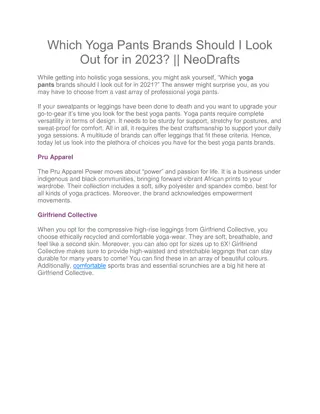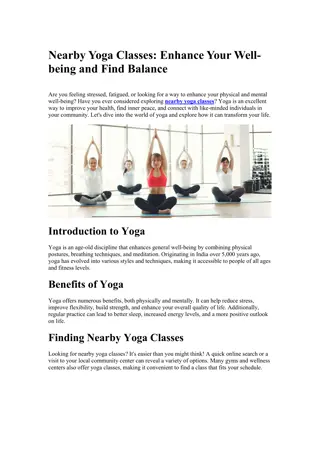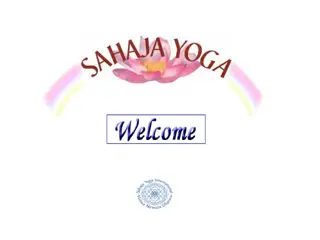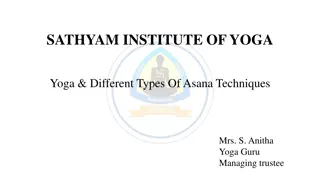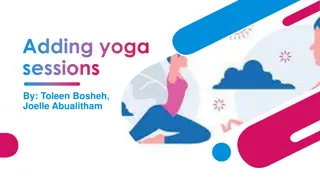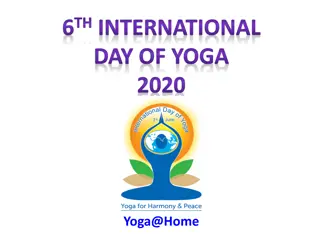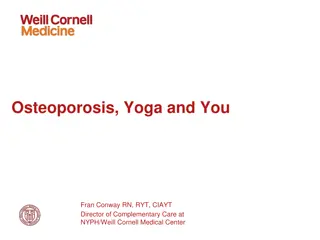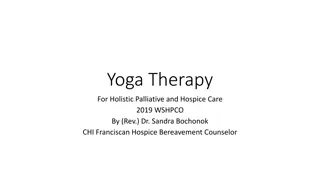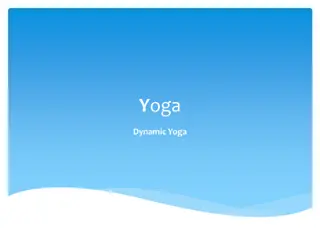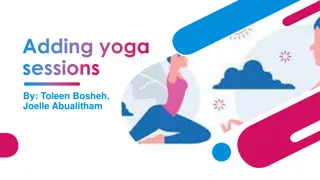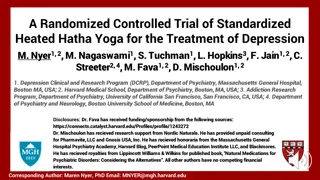Insights into the Lucrative US Yoga Market
The US yoga market experienced substantial growth according to a 2016 report by Yoga Journal. Revenues reached $16.8 billion, with a 60% increase since 2012, and the number of practitioners rose by 76.4%. Classes, apparel, equipment, and accessories all contributed to this thriving industry, with classes accounting for the largest segment. More details on practitioner profiles, practicing trends, motivations, and barriers were also outlined in the report.
Download Presentation

Please find below an Image/Link to download the presentation.
The content on the website is provided AS IS for your information and personal use only. It may not be sold, licensed, or shared on other websites without obtaining consent from the author.If you encounter any issues during the download, it is possible that the publisher has removed the file from their server.
You are allowed to download the files provided on this website for personal or commercial use, subject to the condition that they are used lawfully. All files are the property of their respective owners.
The content on the website is provided AS IS for your information and personal use only. It may not be sold, licensed, or shared on other websites without obtaining consent from the author.
E N D
Presentation Transcript
A Healthy Revenue Generator According to a 2016 Yoga Journal report, the US yoga market, including classes, clothing, equipment and accessories, generated revenues of $16.8 billion, an increase of 60% from 2012. The number of Americans practicing yoga increased 76.4% from 2012, to 36.7 million. Eight percent of respondents reported having participated in a yoga class that same day (3%) or during the last week (5%) and an additional 4% within the month. More than a third (34%) of Americans, totaling 80 million people, said they are somewhat or very likely to practice yoga during the next year. Almost a quarter (23%) of lapsed practitioners said they are likely to try yoga again during the next year.
Big Money in Mindful Practice Classes are the largest part of the yoga market, at $5.8 billion, or 35.4% of the total. Yoga apparel is the next biggest segment, at $4.6 billion, followed by equipment, $3.6 billion, and accessories, $2.8 billion. Many studios also sell products. Yoga class expenditures more than doubled (+132%) from 2012 to 2016. Spending on yoga apparel increased 109% and yoga equipment, 56%. The largest group, or 31%, of yoga practitioners do not pay per yoga class or pass while 27% pay less than $50; 17%, $50 $99; 11%, $100 $199; and 14%, more than $200.
Yoga Practitioner Profile More than seven in ten (72%) yoga practitioners are women. More than a third (37%) said they have a child younger than 18 who has taken a yoga class. Almost half (44%) have practiced 10+ years; 17%, 6 10 years; 30%, 1 5 years; and 7% >1 year. Yoga practitioners come from every age group: 18 29, 19%; 30 39, 23%; 40 49, 20%; 50 59, 17%; and older than 60, 21%. The Mid-Atlantic region has the most practitioners at 8.0 million, followed by the Pacific states, 6.8 million; Southeast, 7.7 million; Midwest, 4.4 million; Southwest, 3.6 million; Mountain, 2.1 million; and New England, 1.0 million.
Yoga Here, There, Everywhere Yoga, unlike other forms of group exercise, is frequently practiced outside the studio. In fact, 81% of yoga practitioners did so during the last year; 30%, the previous week; 23%, the previous month; and 7%, the previous day. Almost all (91%) yoga enthusiasts are satisfied with their current studio. Almost two-thirds (65%) practice at home; 48%, a health club/gym; 45%, a yoga studio; 21%, a community center; 15%, a park; 12%, a beach; 10% a hotel; and 9%, a spa. More than a quarter of practitioners have left a class early and the biggest reason was overcrowding, at 11%; followed by teacher was not good, 7%; felt ill, 7%; other, 7%; and did not like the style of yoga practiced, 6%.
Motivations to Start Yoga (or Not) Becoming more flexible was the #1 reason yoga practitioners decided to start yoga, at 61%; followed by stress reduction, 56%; general fitness or conditioning, 49%; improving overall health, 49%; and physical fitness, 44%. Although spiritual development is part of yoga, only 24% cited this as a reason to participate and 37% for mental health reasons. Only 21% said it was for weight loss. Three-quarters of Americans strongly or somewhat agree yoga is good for you. Perceptions of exclusivity, such as yoga is for very flexible people, yoga is for young people, yoga is not physical enough and yoga is spiritual, are barriers to trying yoga. Perceptions that yoga is a form of meditation, however, had a positive impact for trying it.
Studio Specifics More than a quarter (27%) of yoga studio managers and owners said their studio has been in operation 11 or more years; 38%, 6 10 years; 38%, 2 5 years; and 6%, fewer than 2 years. Almost two-thirds (62%) said the yoga space in their studio is dedicated to yoga, while 37% said it was also used for other activities. More than half (56%) supplement yoga class revenues, particularly with wellness services, 72%; products, 66%; and subletting, 2%. More than half of studios (51%) have 100 or fewer students per week; 18%, 101 200; 19%, 201 500; and 11% more than 500.
Advertising Strategies Promote a limited-time, free introductory class for new students. Emphasize the ability of yoga to make people more flexible and prevent injuries regardless of age. Approach major employers in your area to interest them in adding yoga and meditation classes as an employee perk to energize employees and develop better concentration to maximize productivity.
New Media Strategies Institute a digital referral program, so current students can earn points toward free classes by referring friends. Find new students by joining and posting in active (running, gym, etc.) Facebook groups, since people who do yoga also tend to participate in other physical activities. When a student masters a difficult pose, take his or her photo and/or record a video and post it on the studio s social media accounts. Tag the customer so he or she can re-post it.





